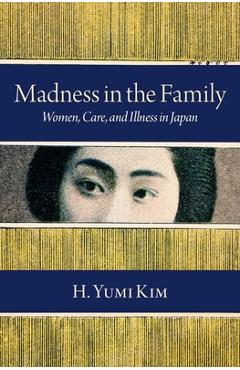Madness in the Family: Women, Care, and Illness in Japan - H. Yumi Kim

Detalii Madness in the Family: Women,
libris.ro
384.74 Lei
480.92 Lei
Medical
H. Yumi Kim
Madness in the Family: Women, - Disponibil la libris.ro
Pe YEO găsești Madness in the Family: Women, de la H. Yumi Kim, în categoria Medical.
Indiferent de nevoile tale, Madness in the Family: Women, Care, and Illness in Japan - H. Yumi Kim din categoria Medical îți poate aduce un echilibru perfect între calitate și preț, cu avantaje practice și moderne.
Preț: 384.74 Lei
Caracteristicile produsului Madness in the Family: Women,
- Brand: H. Yumi Kim
- Categoria: Medical
- Magazin: libris.ro
- Ultima actualizare: 25-10-2024 01:12:27
Comandă Madness in the Family: Women, Online, Simplu și Rapid
Prin intermediul platformei YEO, poți comanda Madness in the Family: Women, de la libris.ro rapid și în siguranță. Bucură-te de o experiență de cumpărături online optimizată și descoperă cele mai bune oferte actualizate constant.
Descriere magazin:
To fend off American and European imperialism in the nineteenth century, Japan strove to strengthen itself by drawing on the most updated ideas and practices from around the world. By the 1880s, this included the introduction of Western-derived psychiatry and its ideas about mental illness. The first Japanese psychiatrists claimed that mental illnesses required medical treatment in specialized institutions rather than confinement at home, as had been common practice. Yet the state implemented no social welfare policies to make new medical services more accessible and affordable to the public. The family, especially women, thus continued to carry the burden of caring for those considered mad. Madness in the Family examines how the family in Japan came to be seen as the natural provider of care for those suffering from mental illnesses. It centers on the experiences of women and families, which have long been obscured by the voices of male psychiatrists, state officials, and lawmakers. H. Yumi Kim traces how women and families negotiated a dizzying array of claims about madness and its proper management across various settings. In the countryside, psychiatrists tried to refute the notion that fox spirits could cause madness, and the government regulated the use of cage-like structures inside homes. In cities, a booming medical marketplace spread ideas about feminized illnesses such as hysteria, and female defendants were evaluated for menstruation-induced disorders. As women and families navigated this shifting therapeutic landscape, they produced their own gendered approaches to madness that would take precedence over the claims of psychiatry, the law, and the state in everyday life. Decoupling the history of mental illness from the discipline and institutions of psychiatry, Madness in the Family reveals the power and fragilities of gender, kinship, and care in the creation of different modes of caring for and understanding mental illness that persist to this day.

Produse asemănătoare

The Devil in the White City: Murder, Magic, and Madness at the Fair That Changed America - Erik Larson
![]() libris.ro
libris.ro
Actualizat in 15/12/2024
94.24 Lei
![The House of Gucci [Movie Tie-In]: A True Story of Murder, Madness, Glamour, and Greed - Sara Gay Forden](https://www.libris.ro/img/pozeprod/26783/26782392-1-small-1.jpg)
The House of Gucci [Movie Tie-In]: A True Story of Murder, Madness, Glamour, and Greed - Sara Gay Forden
![]() libris.ro
libris.ro
Actualizat in 15/12/2024
99.15 Lei

Marvel Studios\' Doctor Strange in the Multiverse of Madness: The Art of the Movie -
![]() libris.ro
libris.ro
Actualizat in 15/12/2024
297.6 Lei

Candace Pert: Genius, Greed, and Madness in the World of Science - Pamela Ryckman
![]() libris.ro
libris.ro
Actualizat in 15/12/2024
148.8 Lei

The Devil in the White City: Murder, Magic, and Madness at the Fair That Changed America - Erik Larson
![]() libris.ro
libris.ro
Actualizat in 15/12/2024
89.23 Lei

Madness in Civilization: A Cultural History of Insanity, from the Bible to Freud, from the Madhouse to Modern Medicine - Andrew Scull
![]() libris.ro
libris.ro
Actualizat in 15/12/2024
138.63 Lei
Produse marca H. Yumi Kim

Madness in the Family: Women, Care, and Illness in Japan - H. Yumi Kim
![]() libris.ro
libris.ro
Actualizat in 25/10/2024
384.74 Lei